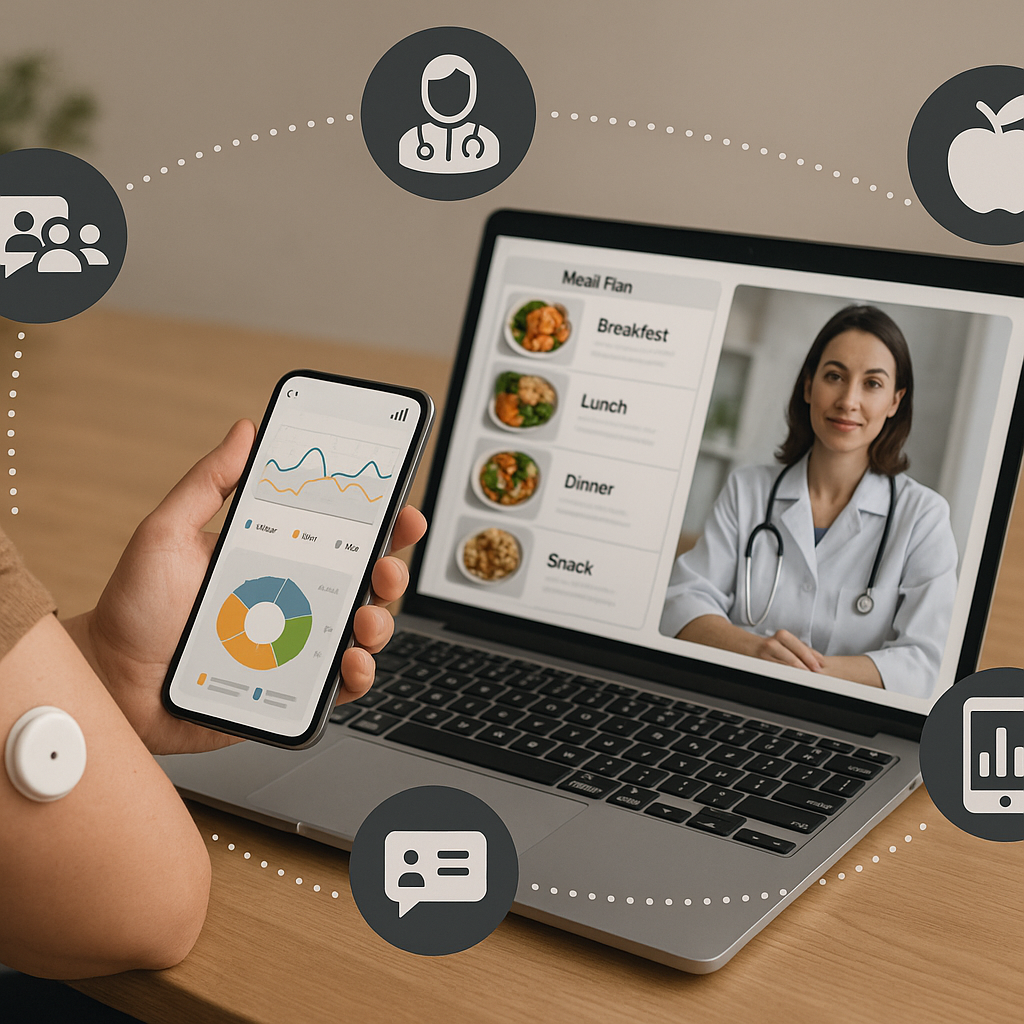A New Era in Diabetes Advocacy and Innovation
Across the globe, diabetes affects over 500 million people, with type 1 and type 2 diabetes increasingly becoming public health priorities. As the prevalence of this chronic condition continues to surge, an often-underappreciated force has been making groundbreaking strides in both research and patient advocacy: diabetes charities. These organizations, many operating as trusted diabetes non profits, are doing far more than fundraising. They are directly influencing medical research, accelerating treatment breakthroughs, shaping policy, and empowering patients. By mobilizing community support, engaging researchers, and funding essential projects, these nonprofits have transformed from support networks into engines of scientific progress.
You may also like: Breakthroughs in Current Diabetes Research: What the Latest Studies Reveal About Treatment and Prevention
Within this dynamic ecosystem, major diabetes charity organizations like the Juvenile Diabetes Research Foundation (JDRF), Diabetes UK, and Beyond Type 1 have become central players in the development of novel therapies and public education campaigns. Their collective efforts, bolstered by donations and strategic partnerships, are helping to push the frontiers of what’s possible in diabetes management and, ultimately, the pursuit of a cure. In this article, we’ll explore how these diabetes charities are spearheading innovation, what new breakthroughs have emerged from their initiatives, and how their presence on trusted diabetes websites serves as a vital lifeline for millions.

The Expanding Role of Diabetes Nonprofits in Medical Research
Historically, diabetes research was often concentrated within academic institutions and government-funded health agencies. While these bodies continue to play essential roles, diabetes non profit organizations have stepped in to fill a critical gap: targeted funding and agile execution. Unlike bureaucratic entities, these charities can often direct resources more swiftly to promising projects, particularly those that may be seen as too niche or early-stage for traditional grant mechanisms. This agility has allowed them to support high-risk, high-reward studies that have led to paradigm-shifting outcomes.
One prime example is the work of the diabetes foundation known as JDRF. Since its founding in 1970, JDRF has invested over $2.5 billion in type 1 diabetes research, supporting a diverse range of studies from immunotherapy to beta cell regeneration. By identifying areas of urgent unmet need, such as early detection tools and disease-modifying treatments, JDRF has positioned itself at the cutting edge of translational research. The foundation’s unique ability to convene scientists, clinicians, and industry partners has fostered an environment ripe for collaboration, yielding results that would be difficult for any single academic entity to achieve alone.
Moreover, diabetes charities are becoming more sophisticated in how they deploy their resources. Many have adopted venture philanthropy models, strategically investing in biotech startups with the potential to deliver real-world solutions. This approach ensures that every dollar raised is not only advancing science but also pushing treatments closer to market readiness. As a result, these charities are redefining what it means to be a stakeholder in the world of medical discovery.

Transforming Lives Through Groundbreaking Treatments and Trials
The funding and organizational expertise provided by diabetes charities have led to concrete medical advancements that are now reshaping diabetes care. One of the most exciting areas of progress is the development of artificial pancreas systems—a major leap forward in automating blood sugar control. JDRF played a central role in the early development and clinical trials of these systems, investing tens of millions into closed-loop insulin delivery technology. Today, these devices are commercially available and dramatically improving quality of life for people with type 1 diabetes.
Beyond device innovation, diabetes charity organizations have also been instrumental in supporting drug development and precision medicine. For instance, several national diabetes nonprofits are funding clinical trials exploring the use of GLP-1 receptor agonists, SGLT2 inhibitors, and other medications for both type 1 and type 2 diabetes. These trials are not only examining efficacy and safety but are also working to personalize treatments based on genetic and lifestyle factors, ushering in a more individualized era of care.
The impact of these innovations is profound. Patients who once relied solely on multiple daily injections and rigorous glucose monitoring can now benefit from streamlined therapies that reduce complications and improve glycemic stability. These advances are particularly important in underserved communities, where diabetes complications often go untreated. With greater access to educational resources through diabetes websites maintained by these organizations, more individuals are empowered to take control of their health outcomes.

Driving Global Awareness and Community-Based Prevention
While research and innovation are central to the mission of many diabetes foundations, equally important is their role in raising awareness and promoting prevention. National diabetes organizations often lead large-scale public health campaigns aimed at educating communities about risk factors, symptoms, and the importance of early diagnosis. These initiatives have proven especially crucial in addressing type 2 diabetes, which is often preventable through lifestyle changes.
Diabetes charities are working closely with schools, employers, and healthcare providers to disseminate critical information. For example, campaigns such as “Know Your Risk” by Diabetes UK or “Screen at 23” in the United States encourage routine screening and early intervention, particularly in high-risk populations. These outreach efforts are increasingly multilingual and culturally tailored, recognizing the diverse communities affected by diabetes.
Many of these programs are accessible through centralized diabetes websites, which serve as trusted hubs of medically reviewed content, downloadable toolkits, and local support directories. By offering these digital resources, diabetes nonprofits extend their reach far beyond physical borders, enabling individuals across continents to access life-saving information. Importantly, these websites are often among the top search results for individuals seeking guidance, illustrating the critical SEO-savvy role that digital presence plays in health education.

Empowering the Next Generation of Scientists and Advocates
An often-overlooked dimension of diabetes charities is their commitment to training future leaders in diabetes care and research. Through fellowship programs, scholarships, and mentoring initiatives, many of these nonprofits are cultivating the next generation of scientists, clinicians, and patient advocates. By investing in human capital, diabetes charity organizations ensure that the fight against this chronic condition is sustained and evolving.
For instance, the American Diabetes Association (ADA), a leading national diabetes organization, offers research grants to early-career investigators whose innovative ideas might otherwise go unfunded. Similarly, JDRF’s T1D Fund helps startup founders and biotech entrepreneurs translate laboratory discoveries into viable treatments. These initiatives not only advance the science of diabetes but also democratize opportunity by supporting diverse voices and disciplines.
Patient advocacy training is another cornerstone of this empowerment strategy. Nonprofits like Beyond Type 1 provide structured programs that teach individuals how to share their stories with policymakers, challenge stigma, and drive legislative change. The resulting grassroots network has amplified the collective voice of the diabetes community, helping to secure insurance coverage for critical supplies, such as continuous glucose monitors and insulin pumps.
In parallel, many diabetes websites feature dedicated sections for youth engagement, storytelling, and peer mentoring. These platforms give young people living with diabetes the tools to lead, connect, and inspire others, ensuring that personal experience becomes a powerful catalyst for change.

Fostering Innovation Through Strategic Collaboration and Funding Models
The success of modern diabetes charities can also be traced to their increasingly strategic approach to collaboration and funding. Gone are the days when nonprofits operated in silos; today’s diabetes non profit organizations are forming alliances across sectors—pairing with pharmaceutical companies, academic institutions, technology firms, and even government bodies. These partnerships amplify impact by combining scientific rigor with financial agility and broad reach.
A hallmark of this model is the venture philanthropy approach, in which diabetes foundations make equity investments in for-profit startups developing promising therapies or devices. This dual-purpose funding strategy allows nonprofits to not only accelerate research but also share in financial returns that can be reinvested into further charitable activities. For example, JDRF’s investment in companies like Tolerion and Pandion Therapeutics has fueled work on immune-modulating therapies for type 1 diabetes, which could dramatically alter disease progression.
Another major innovation is the use of challenge grants and milestone-based funding, where support is contingent upon achieving specific research goals. This model ensures accountability and scientific rigor while encouraging efficient progress. Some diabetes charities also utilize public-private partnerships to co-fund large-scale initiatives such as national registries, biobanks, and real-world data platforms, which are essential for long-term research.
These adaptive funding models are a testament to the evolving role of diabetes charity organizations as not just supporters of research, but architects of an entire ecosystem that nurtures innovation. Their savvy use of data analytics, stakeholder engagement, and outcome measurement ensures that resources are directed to the areas of highest potential.

The Power of Patient-Centered Digital Platforms
A defining feature of today’s leading diabetes nonprofits is their investment in digital infrastructure. As more individuals turn to the internet for health information, diabetes websites operated by these organizations have become critical tools for education, support, and self-management. Far from being simple brochures, these platforms now serve as interactive ecosystems offering symptom checkers, telehealth referrals, nutrition guides, and mobile apps.
Importantly, these digital platforms are grounded in evidence-based information, with content curated by medical professionals and regularly updated to reflect current guidelines. Visitors can explore everything from insulin pump comparisons to recipes for blood sugar-friendly meals, all within a few clicks. These resources demystify complex topics and empower users to make informed decisions about their health.
Many of these websites also offer forums and live events, creating a sense of community and reducing the isolation often experienced by individuals with chronic illness. Whether someone is newly diagnosed or managing diabetes for decades, these platforms offer both information and belonging. Through data analytics, charities can track user behavior and continuously improve offerings, ensuring relevance and usability.
The success of these digital strategies reinforces the vital role that diabetes charities play in shaping not just treatment landscapes, but the broader experience of living with diabetes. By meeting people where they are—on their phones, computers, and social media feeds—these nonprofits are transforming education into action
Frequently Asked Questions: Diabetes Charities, Nonprofits, and Their Role in Advancing Research and Support
1. How do diabetes charities influence health equity in underserved communities?
Diabetes charities play a crucial role in narrowing the gap in healthcare access for underserved populations. By funding outreach initiatives, free screening programs, and culturally tailored education, these organizations ensure that minority and low-income communities receive critical support. Many diabetes charity organizations partner with local clinics and community centers to deliver services in neighborhoods that traditionally lack sufficient medical infrastructure. Moreover, national diabetes nonprofits have begun focusing on social determinants of health, such as food insecurity and housing instability, to address the broader context of diabetes management. Their work helps make high-quality care more accessible and equitable across socioeconomic divides.
2. What innovations are diabetes nonprofits exploring beyond traditional research grants?
Today’s diabetes non profit leaders are embracing a spectrum of innovative funding models. Instead of simply awarding grants, some diabetes foundation initiatives now invest in impact-driven startups working on next-gen therapies or data platforms. This venture philanthropy model not only accelerates drug development but allows diabetes charities to generate returns that can be reinvested into new programs. Additionally, blockchain-based health record systems, machine-learning diagnostics, and patient-centered mobile apps are among the tech-focused innovations being supported. These shifts illustrate how nonprofits are becoming catalysts for digital transformation in chronic disease care.
3. How do diabetes websites help individuals manage their condition more effectively?
Unlike static health pamphlets of the past, modern diabetes websites function as comprehensive, interactive platforms. Many leading diabetes charity organizations maintain websites that offer symptom checkers, medication management tools, nutritional databases, and community forums. These tools support real-time decision-making and ongoing disease monitoring. Additionally, curated articles and webinars help users stay informed about evolving treatment guidelines and emerging therapies. By empowering individuals with personalized digital resources, diabetes websites are transforming self-management into a more proactive and informed experience.
4. Are diabetes foundation-supported research efforts influencing public health policies?
Yes, many diabetes foundations are actively involved in shaping legislative and regulatory landscapes. For example, advocacy teams from diabetes charities often work with lawmakers to improve insurance coverage for essential supplies like insulin pumps and continuous glucose monitors. Their lobbying has led to increased federal funding for diabetes research and improved public school protocols for students with diabetes. Through white papers, expert panels, and patient testimony, these foundations influence the policies that govern care access and quality. Their involvement ensures that scientific progress translates into systemic change.
5. What long-term mental health initiatives are supported by diabetes charity organizations?
Mental health is increasingly recognized as an inseparable part of diabetes care, and many diabetes charities are integrating emotional support into their service models. Several nonprofits offer peer counseling programs, virtual support groups, and therapist referral networks through their diabetes websites. Some are even collaborating with universities to study the impact of diabetes-related distress on treatment adherence and glycemic outcomes. These mental health efforts are particularly important for adolescents and newly diagnosed patients, who often face stigma or psychological overwhelm. By prioritizing emotional well-being, diabetes foundations provide more holistic and humane care solutions.
6. How are national diabetes organizations addressing type 2 diabetes prevention at the population level?
Prevention is central to the mission of most national diabetes organizations, especially given the lifestyle-driven nature of type 2 diabetes. Beyond educational campaigns, these nonprofits fund community-based initiatives that integrate diet counseling, physical activity programs, and biometric screening. Many also support policy reform around urban planning and food labeling to promote healthier environments. Some diabetes charity organizations are now implementing digital prevention programs using wearable tech to track health metrics and guide behavior change. By operating at both the individual and systemic levels, they are actively reshaping the risk landscape.
7. What role do patients play in shaping the agendas of diabetes nonprofits?
Today’s diabetes non profit organizations are increasingly patient-driven in their operations. Many incorporate patient advisory boards to guide research funding, program design, and advocacy priorities. Through surveys, online forums, and ambassador programs, patients help ensure that nonprofit strategies reflect lived experiences. This participatory model fosters greater trust and efficacy, aligning services with real-world needs rather than top-down assumptions. As a result, diabetes charities are evolving into collaborative ecosystems where community insight drives institutional action.
8. How do diabetes charities measure the success of their initiatives?
Metrics for evaluating success have become increasingly sophisticated within diabetes foundation programs. Rather than focusing solely on fundraising totals, charities now use key performance indicators such as clinical trial enrollment rates, policy wins, digital engagement, and reductions in diabetes-related hospitalizations. Some are investing in longitudinal data tracking through electronic health records and patient registries. These evaluation strategies enable continuous improvement and evidence-based allocation of resources. Ultimately, this commitment to transparency reinforces public confidence in diabetes charities and their long-term impact.
9. What are some emerging international collaborations among diabetes charity organizations?
Global health challenges require collective solutions, and many diabetes charities are now participating in cross-border alliances. Initiatives such as the Global Diabetes Compact by the World Health Organization have attracted support from leading national diabetes nonprofits. These collaborations focus on harmonizing treatment standards, pooling research funding, and expanding access to insulin in low-resource settings. By coordinating efforts across continents, diabetes foundation partnerships are helping to address the worldwide burden of diabetes more efficiently. This shift toward internationalism signals a new era of united advocacy and research.
10. How can individuals engage meaningfully with the work of diabetes charities beyond donating?
There are many ways to contribute to the mission of diabetes charities beyond financial support. Volunteering at local screenings, mentoring newly diagnosed patients, participating in research studies, or contributing personal stories to diabetes websites are all valuable actions. Many diabetes charity organizations also run ambassador programs that train individuals to advocate for policy change and public awareness. By integrating their skills—whether in marketing, data science, education, or event planning—supporters can become powerful agents of change. These nonprofits thrive when the community they serve becomes part of the solution.
Conclusion: The Expanding Legacy of Diabetes Charity Organizations in a Changing World
As the burden of diabetes continues to rise globally, the importance of diabetes charities has never been more evident. Far beyond traditional fundraising, these organizations are catalyzing change across research, care delivery, digital engagement, and public policy. Their role as agile funders, research incubators, and community mobilizers has placed them at the forefront of medical innovation and public health transformation.
From funding next-generation therapies to providing trusted resources through widely used diabetes websites, these nonprofits are filling critical gaps that governmental and private institutions often overlook. Their commitment to patient-centered care, strategic collaboration, and scientific advancement underscores the essential nature of their work in today’s health landscape.
At the heart of these efforts is a shared vision: a world where diabetes is not a lifelong burden but a manageable—and ultimately curable—condition. By investing in science, championing patient voices, and fostering innovation, diabetes charity organizations are bringing that vision closer to reality. For millions living with diabetes today, the hope offered by these nonprofits is not just symbolic—it is tangible, measurable, and transformative.
As we look toward the future, one thing is clear: the continued support of and engagement with these diabetes non profits is essential. Whether through donations, volunteering, advocacy, or sharing trusted content online, every action taken helps to propel this movement forward. In the story of diabetes research and care, these charities are not merely supporting characters—they are leading protagonists, rewriting what’s possible with compassion, courage, and conviction.
Further Reading:
Emerging Breakthroughs In Diabetes Treatment: A New Era Of Hope
A Ray of Hope for a Cure for Type 1 Diabetes
Breakthrough T1D: past, present, and future
Disclaimer
The information contained in this article is provided for general informational purposes only and is not intended to serve as medical, legal, or professional advice. While MedNewsPedia strives to present accurate, up-to-date, and reliable content, no warranty or guarantee, expressed or implied, is made regarding the completeness, accuracy, or adequacy of the information provided. Readers are strongly advised to seek the guidance of a qualified healthcare provider or other relevant professionals before acting on any information contained in this article. MedNewsPedia, its authors, editors, and contributors expressly disclaim any liability for any damages, losses, or consequences arising directly or indirectly from the use, interpretation, or reliance on any information presented herein. The views and opinions expressed in this article are those of the author(s) and do not necessarily reflect the official policies or positions of MedNewsPedia.


